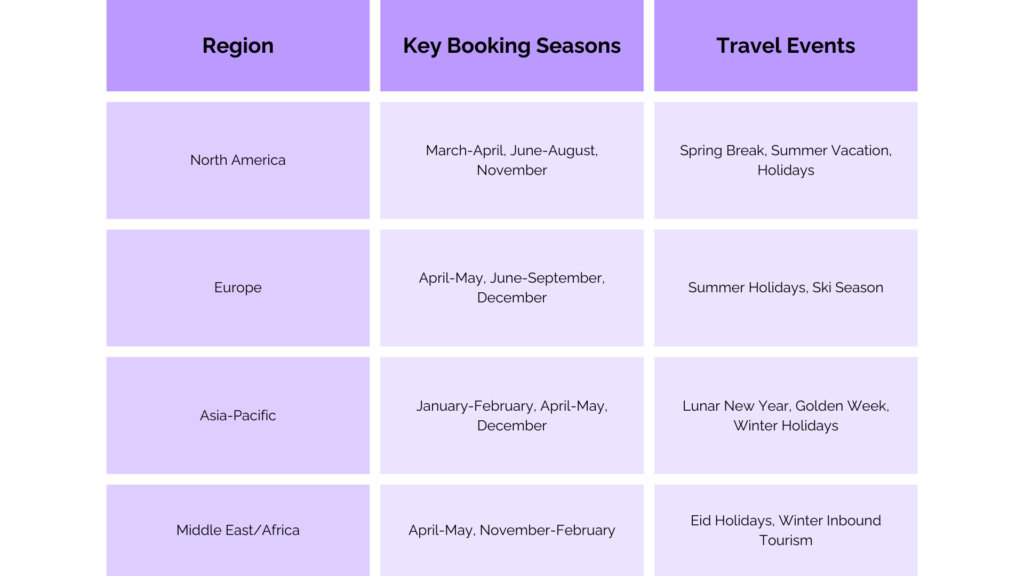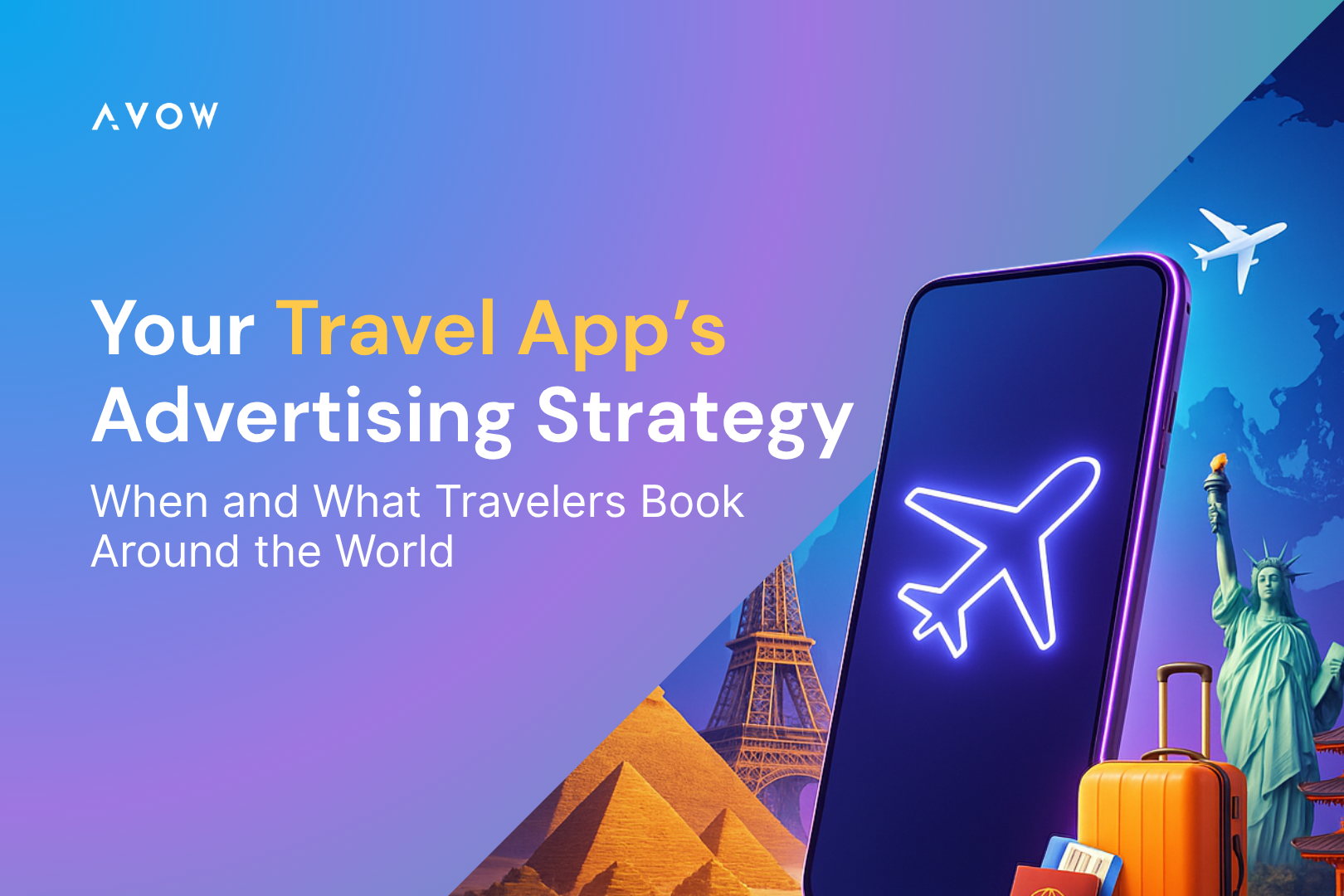Your Travel App’s Advertising Strategy for 2026
Travel intent is strong heading into 2026, but booking windows are barbell-shaped: more early planners (91-180 days out) and more last-minute bookers. Mobile is now the dominant booking platform, and time spent in travel apps continues to climb, so timing and mobile-first ad placements matter more than ever. Retargeting ads drive most conversions in the category, while sustainability signals influence choice at the margin. Below, you’ll find information on when people book, how behavior is shifting, and what sort of ads to run, all backed by data.
Seasonal Booking Patterns (Planning for 2026)
Flights
- Search/plan earlier for summer: The 91-180-day search window grew the fastest in Q2 2025 (≈+50% QoQ; +70% for domestic), signaling earlier planning for peak periods.
- Shorter windows are also rising: Large platforms note shorter booking windows as consumers are in a “wait and see” mode, making decisions closer to their travel dates.
- Volume backdrop: Global passenger traffic growth is slowing but positive (projected +5.8% YoY in 2025 vs +10.6% in 2024). Plan for steadier, but not explosive, demand.
Hotels & Accommodation
- Lead times have been stable overall on big home-share platforms, with lead times in Q2 2025 generally stable YoY. Use price-watch + retargeting for fence-sitters.
- Indicators in the UK/EU: “Sunshine Saturday” bookings surged with an average of £1,753 spent per trip among early bookers—a useful proxy for high-intent cohorts.
Things To Do & Local Experiences
- Advanced planners and impulse travellers coexist: 56% of travelers research/book activities in advance; 25% do so four weeks or more in advance. Same-day, in-destination bookings are still strong → keep “near me” and push messaging live.
How Travelers Behave in 2026 (What to Plan For)
Mobile is the primary channel: Mobile drove ~52% of OTA bookings in 2024, and this share is expected to continue rising through 2026.
Travel apps keep growing: 4.2B downloads (2024, +3% YoY) and >20B hours (+7.3% YoY) spent in travel apps mean more touchpoints to influence discovery and re-engage.
Retargeting is the conversion engine: Over 75% of travel app conversions now come from retargeting/re-engagement (paid and owned). Budget accordingly.
Install-to-purchase is non-trivial: The median install-to-purchase conversion rate is approximately 2.4% for travel apps. Thus, calibrate funnel math and creative testing against this.
Retention reality check: Day-1 ≈18% and day-30 ≈2.8% for travel apps. Protect ROAS by leveraging lifecycle and CRM.
Sustainability influences choice: 93% of travelers say they want to make more sustainable choices; labeling and trustworthy signals are crucial in ad copy and Product Display Pages (PDPs).
Travel Advertising Plays for 2026
- Barbell Your Timing
- Early planners: Start flight/hotel prospecting 4–6 months before summer/Golden Week/Christmas with the use of informative, price-stable creatives.
- Last-minute decision makers: Always-on “48-hour” and “this week” bundles near travel hubs as shorter booking windows are rising.
- Make Retargeting Your No.1 Lever
- Shift more budget to remarketing + owned re-engagement, given that over 75% of conversions are re-engaged users. Use dynamic offers tied to searched destinations/routes/hotels.
- Use Creative + UX to Hit Key Metrics
- Aim to beat ~2.4% install→purchase: Showcase clear prices, flexible change/cancel, loyalty perks; test “free hold” or “price-lock” hooks.
- Design for D1/D30 retention realities with trip-timeline nudges, in-trip upsells, and post-trip review prompts.
- Context Matters
- Expect steady but slower air traffic growth (+5.8% in 2025); don’t over-forecast peaks.
- Watch category demand signals (e.g., earlier summer planning; some markets showing shorter windows).
- Lean into the Mobile App Space
- With apps accounting for over 50% of OTA bookings, prioritize app-install and app-re-engagement over web-only goals; test deep links to saved itineraries.
Month-by-month Travel Timing Cheatsheet (Global Highlights)
Nov-Dec: Holidays; mix of early planners and last-minute travellers; segment messaging by window length.
Jan-Feb: Lunar New Year (APAC) lead times lengthen; start prospecting in Oct-Nov.
March: Carnival (LATAM) and spring breaks; Combine app-only bundles with retargeting to cart abandoners.
May-Aug: Summer peak, earlier search windows open; escalate price-watch and loyalty creatives between Feb-Apr.
Sep-Oct: Shoulder season + Golden Week means pushing flexible, eco-positioned stays; highlight rail where relevant (for eco-conscious travellers)

What to Say (Messaging That Maps to Behavior)
Sustainable picks: “Certified stay,” “low-emission route,” “rail alternatives” — meets 93% sustainability intent.
Trust & flexibility: “Free changes,” “clear fees,” “verified reviews” — reduces friction and improves the install→purchase ≈2.4% hurdle.
Value for early planners: “Price alerts,” “hold this fare,” “book now, pay later” — aligns with expanding 91-180-day planning.
Ready to scale your travel app in 2026?
The key to winning in travel advertising is timing, relevance, and trust. Travelers are booking earlier and later; they expect mobile-first convenience, and they reward brands that offer transparency and sustainable choices.
At AVOW, we help travel apps stand out in the crowded landscape by leveraging mobile OEM advertising, Dynamic Preloads, and alternative app stores to reach over 1.5 billion daily active users worldwide.
Get in touch with AVOW today to learn how we can help you capture intent-driven travelers and turn installs into loyal bookings.
Travel App FAQ
When should we start the 2026 summer campaigns?
Begin prospecting 4-6 months in advance (February-April for July-August travel), as 91-180-day planning has increased significantly. Layer retargeting closer to departure.
How much should we budget for remarketing vs. prospecting?
Skew heavier to remarketing/owned re-engagement, since >75% of conversions now come from re-engaged users in travel apps.
What’s a good conversion target from install to purchase?
Benchmark ~2.4% and optimize creative + offers to beat it by segment (route pairs, stay types, loyalty tiers).
Should we keep web campaigns?
Yes, but the app surface drives over 50% of OTA bookings; prioritize app install and deep-link re-engagement for ROAS.
How does OEM advertising help travel apps in 2026?
OEM advertising places your travel app directly in front of high-intent users through Dynamic Preloads, app store placements, and on-device recommendations on smartphones from brands like Xiaomi, Samsung, Huawei, and OPPO, among others. This channel bypasses the crowded Google-Apple duopoly, drives organic uplift through trusted placements, and ensures your app is visible at the very start of a traveler’s planning journey.
About the Author






